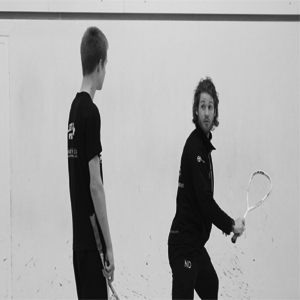The problem with advice is that lots of people who give it to you only see you in a single match, or a particular situation or environment. Therefore, they don’t have a true picture of you in squash; only you have that. So you need to work out what you can take – if anything – from the advice and thoughts offered to you, and how you can make it work for your style and life.
Sometimes the advice itself is wrong, but the point underneath it is right
Someone once said to me that I rush to intercept too many shots before the back wall, but the problem is for me, I am not particularly quick and I am also tall, which means I need to use the volley a lot in order to control the game and attack. They were right in saying that I made a lot of mistakes doing that in this game, but it wasn’t wise medium or long term advice – I need to volley a lot, and so leaving lots of shots to bounce off the back wall isn’t really an option for me.
This isn’t to say there was nothing for me to take from their thoughts. They had correctly spotted I had struggled to intercept the ball with any control or accuracy on a consistent basis. The reason I had been inconsistent was that I was playing someone who was in my opinion a better player, and they played at a higher speed than I was used to, and so my shots and decisions weren’t of the same quality as his. I needed to get experience of playing players who played at a higher tempo so I could acclimatise to volleying in high-speed games. No matter how good you are, if you play someone who is a level or two above you, they can make you look incredibly stupid with their tempo and the time they take away from you.
I also tried to improve my watching and anticipation of the ball, so that I could see volley opportunities earlier and therefore be prepared earlier, which is always helpful when the game is fast. There was also room for improvement in my turning to intercept cross-court shots on the volley, as well as my tracking of the ball. By turning front-on and using my ‘radar eye’, I was able to track the ball better and therefore volley more. All of this helped me to take the ball earlier and thereby be more comfortable at a higher tempo.
Practicalities: doing what you can
Sometimes the advice might be good in theory, but it’s just not practically possible for you. At a higher level, you need more fitness than just playing squash two to three times a week will provide you with. It might be difficult to find the time to start a gym regime, but there are still things you can do to help tip the balance. Stay for an extra 5-10 minutes after you play a match, and try to do lung bursting sets of court sprints – say 20 laps in 55 seconds (or less if you are capable!) or 12 laps in less than 30 seconds. You can aim for more laps or lower time, or give yourself less rest time as you get better. You’d be amazed at how quickly you improve by doing three to five sets once or twice a week. If you really want to test yourself, do the sprints before you play and see how you cope with the match whilst physically struggling.
Tailoring things to individuals is perhaps more widely accepted in the nutritional and physical industries, and in the pursuit of excellence in squash, you’ll need to see what works for you in both of these areas. There’s no one size fits all solution in squash, or any of these industries, so make sure that you don’t blindly accept all the advice and lessons given to you, but weigh them up and see:
- If the person has a valid point – although it may not be exactly what they said, like the volley example given earlier.
- How the theory behind it can be best applied to your lifestyle, personality and game.
Reflect on people’s thoughts in this way and you can squeeze the best out of the knowledge of others to help you develop your ability on the court and understanding of the game.

Leave a Reply